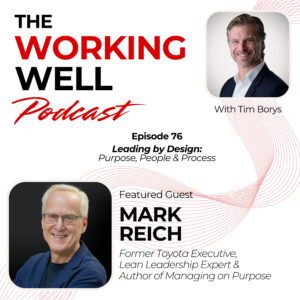
Podcast Summary
In this episode of the Working Well Podcast, host Tim Borys sits down with Mark Reich, Senior Coach and Chief Engineer of Strategy at the Lean Enterprise Institute, and former Toyota executive with more than two decades of experience in Japan and North America.
Mark shares his unique insights on how Hoshin Kanri—Toyota’s powerful strategy deployment process—builds high-performing teams by aligning purpose, people, and performance. He explains how leaders can apply Lean principles beyond manufacturing to any industry, from healthcare to finance, to design organizations that learn, grow, and thrive.
This conversation is a masterclass in purpose-driven leadership, blending strategy, culture, and human development into a practical roadmap for long-term success.
✅ Key Takeaways
Strategy is a living process — Hoshin Kanri connects long-term vision to daily execution.
Leadership is people development — your primary job as a leader is to grow capability.
Go see the work — leaders must understand the real challenges by being present at the “Gemba.”
Fewer priorities, greater focus — success comes from doing less, better.
Culture change starts with behavior — modeling, coaching, and continuous learning drive transformation.
Learning happens on the job — real leadership growth comes through experience, not just theory.
Episode Links & Resources
Connect with Mark here:
Website: lean.org
LinkedIn: https://www.linkedin.com/in/markareich/
New Book: Managing on Purpose
Podcast Highlights
Please note: This highlight is generated by a computer and may contain errors.
Introduction: Leadership by Design
Welcome to the Working Well Podcast. Today’s guest is Mark Reich, Senior Coach and Chief Engineer of Strategy at the Lean Enterprise Institute, who spent more than 23 years at Toyota. He joins host Tim Borys to discuss how purpose, people, and process come together to create organizations that thrive.
Healthy, engaged, and productive teams don’t happen by accident—they happen by design.
Mark’s Journey: Learning from Toyota
Mark shares his journey from studying Japanese in university to working in Japan and North America with Toyota. During his career, he learned that success at Toyota was never about tools—it was about people, learning, and alignment.
At Toyota, leaders are not just responsible for hitting targets—they are responsible for developing people who can achieve those targets.
Hoshin Kanri: The Engine of Strategy Deployment
Mark explains Hoshin Kanri, Toyota’s long-term planning and execution process. It’s not a management fad—it’s a living system that connects vision and action through alignment, feedback, and learning.
Hoshin Kanri ensures that every person in the organization understands:
What the company is trying to achieve
Why it matters
How their work contributes to that purpose
It turns strategy from a document into a shared, daily practice.
People Development as Leadership’s Core
Mark emphasizes that leadership isn’t about authority—it’s about developing people. Leaders must act as coaches, helping their teams think, learn, and grow.
The Toyota philosophy is simple: if you want to be promoted, develop someone to take your place.
The Power of Focus
Most organizations fail because they chase too many priorities. Mark reminds leaders: “Three to five big goals—that’s it.” When everything is a priority, nothing is. Focus creates clarity, and clarity builds alignment.
Go See the Work — “Gemba” Leadership
In Lean philosophy, leaders must go to the Gemba—the real place where work happens. That’s where problems are visible, where learning happens, and where relationships are built. Strategy disconnected from reality is just theory.
Culture Change Through Coaching
Culture doesn’t change through slogans—it changes through daily behaviors.
Mark explains that Toyota developed culture by:
Coaching on the job
Modeling behaviors at every level
Building systems that reinforce learning and feedback
When people see leaders live the values, culture follows.
Applying Lean Beyond Manufacturing
Mark shares how these lessons now apply far beyond factories—into healthcare, finance, education, and even government. Any system that depends on human alignment and learning can benefit from Lean thinking.
Leadership Lessons for Today
Mark’s biggest piece of advice: Think two levels above your role.
Ask yourself how a senior leader would approach this problem. That perspective shift changes how you think and lead.
Closing Thoughts
Leadership by design is about connecting purpose to process and people. It’s about creating systems where everyone can learn, grow, and perform—together.

